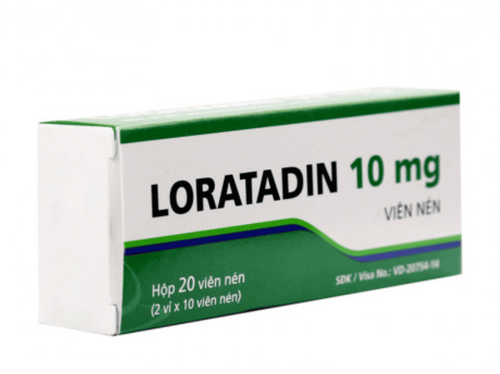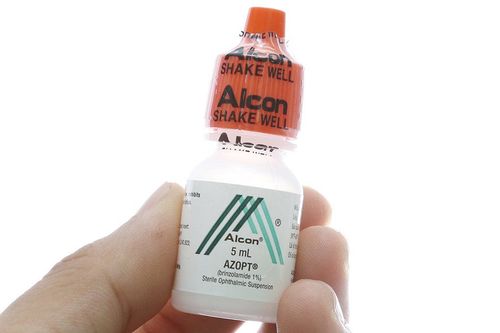This is an automatically translated article.
Alomide is an eye drop commonly used in ophthalmology. So what is the effect of Alomide, what should I pay attention to when using and instilling the medicine correctly to minimize the complications caused by using the wrong eye drops?
1. What is Alomide?
Alomide is an eye drop that contains the active ingredient Lodoxamide 0.1%. What are the uses of Alomide? Alomide is used to treat certain allergic eye conditions (spring conjunctivitis, allergic conjunctivitis, keratitis). Lodoxamide is a mast cell stabilizer that blocks certain natural substances secreted by the body (such as histamine, leukotriene) that cause allergy symptoms.
2. How to use the drug Alomid
Before using Alomide eye drops, wash your hands thoroughly. To avoid contamination, do not touch the dropper tip or let the dropper tip touch your eyes or any other surface. Patient should not wear contact lenses while instillation. Alomide is used for the affected eye, usually in doses 4 times daily or as directed by your doctor, treatment can be continued for 3 months.The patient tilts his head back, looks up, and pulls the lower eyelid down to form a “pocket” to hold the medication. Hold the dropper above the eye and put 1 drop in the eye, look down, and gently close the eye for 1-2 minutes. Place a finger in the corner of the eye near the nose and press gently, this will prevent the medicine from draining out of the eye. Try not to blink and not to rub your eyes immediately after instilling the drops.
Repeat these steps if the dose of each instillation is more than 1 drop and do the same with the other eye. Do not wash the dropper of the medicine bottle after using it. Close the dropper cap tightly after each use. If the person is using another eye medication (for example, drops or ointment), wait at least 5 minutes before continuing with the other medications. Use eye drops before applying eye ointment.
MORE: Mistakes when using eye drops

Người bệnh sử dụng thuốc Alomide cần tuân thủ đúng chỉ định của bác sĩ
Use Alomide regularly to achieve the best treatment effect. For ease of remembering, take Alomide at the same times each day and continue taking it for the full prescribed time. It may take up to a few days of use to begin to notice relief of symptoms. If immediate relief of eye discomfort (itching) is needed, use another quick-release pain reliever (such as antihistamine eye drops, decongestant, or nonsteroidal anti-inflammatory drug (NSAID)) along with lodoxamide as directed. doctor's instructions. Tell your doctor if your discomfort persists or gets worse.
3. Side effects of the drug Alomide?
Side effects of Alomide may be encountered such as: uncomfortable stinging, feeling of being there, dry nose, sneezing, headache, dizziness, drowsiness, blurred vision, watery eyes, dry eyes , a sticky feeling in the eyes or on the eyelids may occur,... If any of these effects persist or get worse, tell your doctor right away.
Tell your treating doctor if you have any of the following rare but very serious side effects of Alomide: eye pain, swelling in or around the eyes, burning sensation in the eyes, vision changes. Allergic reactions to Alomide, although very rare, can still occur serious allergies such as: rash, itching, swelling of the face/tongue/throat, difficulty breathing, severe dizziness...
MORE: Yes Should conjunctivitis medication be discontinued when an allergy is suspected?

Thuốc Alomide có thể gây tác dụng phụ như mờ mắt hoặc chảy nước mắt
4. Notes when using the drug Alomid
To ensure safety, when using Alomide, the patient should note the following issues:Before using eye drops containing the active ingredient lodoxamide, tell the treating doctor or pharmacist if the patient has had history of allergy to this active substance or any other allergies as well as the patient's medical history. After instillation, vision may be temporarily blurred. Alomide rarely makes users dizzy or drowsy. However, alcohol or drug use can make dizziness or drowsiness worse. Therefore, do not drive, use machines, or do anything that requires alertness or requires vision. Limit the use of alcoholic beverages while taking the drug. For pregnant women, Alomide should only be used when absolutely necessary and it is best to consult a specialist before taking it. An overdose of the drug can lead to serious symptoms such as fainting or difficulty breathing. Alomide is an eye drop, so it can be harmful if swallowed. Symptoms after swallowing lodoxamide may include: flushing, feeling warm and feverish, unusual tiredness, sweating, diarrhea. Avoid allergens that can cause eye inflammation. Some common allergens that cause eye allergies include pollen, weeds, dust mites, and pet dander. Do not share this bottle of eye drops with other people. If the patient misses a dose, drop the dose as soon as you remember. If it is almost time for your next dose, skip the missed dose and use your next dose as usual, do not double the dose. Store the dropper bottle in an upright position at room temperature 15 - 27 degrees Celsius, protected from light and moisture, out of reach of children and pets. Alomide is an eye drop containing the active ingredient Lodoxamide, which is prescribed by doctors to treat eye allergies and conjunctivitis. To avoid unwanted side effects, patients need to follow the doctor's instructions. In case the use of the drug is not effective, the patient should stop taking the drug and go to the medical facility for examination, treatment and appropriate prescription.
Vinmec International General Hospital is the address for examination, treatment and prevention of diseases. When performing the examination process at Vinmec, customers will be welcomed and used the modern facilities and machinery system along with perfect medical services under the guidance and advice of the doctors. Good doctors, well-trained both at home and abroad.
Please dial HOTLINE for more information or register for an appointment HERE. Download MyVinmec app to make appointments faster and to manage your bookings easily.
Reference source: webmd.com












